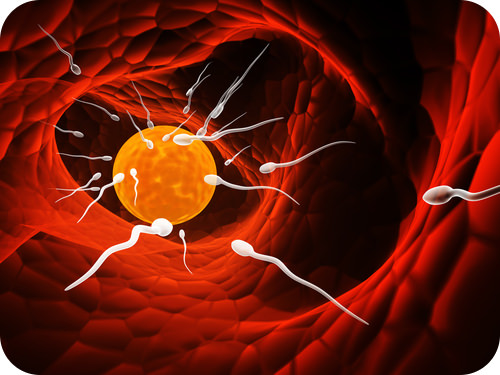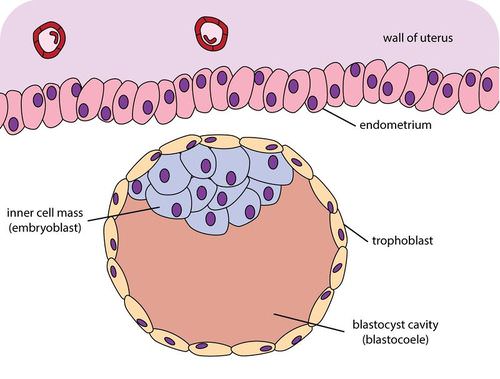13.61: Fertilización
- Page ID
- 108167
\( \newcommand{\vecs}[1]{\overset { \scriptstyle \rightharpoonup} {\mathbf{#1}} } \)
\( \newcommand{\vecd}[1]{\overset{-\!-\!\rightharpoonup}{\vphantom{a}\smash {#1}}} \)
\( \newcommand{\dsum}{\displaystyle\sum\limits} \)
\( \newcommand{\dint}{\displaystyle\int\limits} \)
\( \newcommand{\dlim}{\displaystyle\lim\limits} \)
\( \newcommand{\id}{\mathrm{id}}\) \( \newcommand{\Span}{\mathrm{span}}\)
( \newcommand{\kernel}{\mathrm{null}\,}\) \( \newcommand{\range}{\mathrm{range}\,}\)
\( \newcommand{\RealPart}{\mathrm{Re}}\) \( \newcommand{\ImaginaryPart}{\mathrm{Im}}\)
\( \newcommand{\Argument}{\mathrm{Arg}}\) \( \newcommand{\norm}[1]{\| #1 \|}\)
\( \newcommand{\inner}[2]{\langle #1, #2 \rangle}\)
\( \newcommand{\Span}{\mathrm{span}}\)
\( \newcommand{\id}{\mathrm{id}}\)
\( \newcommand{\Span}{\mathrm{span}}\)
\( \newcommand{\kernel}{\mathrm{null}\,}\)
\( \newcommand{\range}{\mathrm{range}\,}\)
\( \newcommand{\RealPart}{\mathrm{Re}}\)
\( \newcommand{\ImaginaryPart}{\mathrm{Im}}\)
\( \newcommand{\Argument}{\mathrm{Arg}}\)
\( \newcommand{\norm}[1]{\| #1 \|}\)
\( \newcommand{\inner}[2]{\langle #1, #2 \rangle}\)
\( \newcommand{\Span}{\mathrm{span}}\) \( \newcommand{\AA}{\unicode[.8,0]{x212B}}\)
\( \newcommand{\vectorA}[1]{\vec{#1}} % arrow\)
\( \newcommand{\vectorAt}[1]{\vec{\text{#1}}} % arrow\)
\( \newcommand{\vectorB}[1]{\overset { \scriptstyle \rightharpoonup} {\mathbf{#1}} } \)
\( \newcommand{\vectorC}[1]{\textbf{#1}} \)
\( \newcommand{\vectorD}[1]{\overrightarrow{#1}} \)
\( \newcommand{\vectorDt}[1]{\overrightarrow{\text{#1}}} \)
\( \newcommand{\vectE}[1]{\overset{-\!-\!\rightharpoonup}{\vphantom{a}\smash{\mathbf {#1}}}} \)
\( \newcommand{\vecs}[1]{\overset { \scriptstyle \rightharpoonup} {\mathbf{#1}} } \)
\( \newcommand{\vecd}[1]{\overset{-\!-\!\rightharpoonup}{\vphantom{a}\smash {#1}}} \)
\(\newcommand{\avec}{\mathbf a}\) \(\newcommand{\bvec}{\mathbf b}\) \(\newcommand{\cvec}{\mathbf c}\) \(\newcommand{\dvec}{\mathbf d}\) \(\newcommand{\dtil}{\widetilde{\mathbf d}}\) \(\newcommand{\evec}{\mathbf e}\) \(\newcommand{\fvec}{\mathbf f}\) \(\newcommand{\nvec}{\mathbf n}\) \(\newcommand{\pvec}{\mathbf p}\) \(\newcommand{\qvec}{\mathbf q}\) \(\newcommand{\svec}{\mathbf s}\) \(\newcommand{\tvec}{\mathbf t}\) \(\newcommand{\uvec}{\mathbf u}\) \(\newcommand{\vvec}{\mathbf v}\) \(\newcommand{\wvec}{\mathbf w}\) \(\newcommand{\xvec}{\mathbf x}\) \(\newcommand{\yvec}{\mathbf y}\) \(\newcommand{\zvec}{\mathbf z}\) \(\newcommand{\rvec}{\mathbf r}\) \(\newcommand{\mvec}{\mathbf m}\) \(\newcommand{\zerovec}{\mathbf 0}\) \(\newcommand{\onevec}{\mathbf 1}\) \(\newcommand{\real}{\mathbb R}\) \(\newcommand{\twovec}[2]{\left[\begin{array}{r}#1 \\ #2 \end{array}\right]}\) \(\newcommand{\ctwovec}[2]{\left[\begin{array}{c}#1 \\ #2 \end{array}\right]}\) \(\newcommand{\threevec}[3]{\left[\begin{array}{r}#1 \\ #2 \\ #3 \end{array}\right]}\) \(\newcommand{\cthreevec}[3]{\left[\begin{array}{c}#1 \\ #2 \\ #3 \end{array}\right]}\) \(\newcommand{\fourvec}[4]{\left[\begin{array}{r}#1 \\ #2 \\ #3 \\ #4 \end{array}\right]}\) \(\newcommand{\cfourvec}[4]{\left[\begin{array}{c}#1 \\ #2 \\ #3 \\ #4 \end{array}\right]}\) \(\newcommand{\fivevec}[5]{\left[\begin{array}{r}#1 \\ #2 \\ #3 \\ #4 \\ #5 \\ \end{array}\right]}\) \(\newcommand{\cfivevec}[5]{\left[\begin{array}{c}#1 \\ #2 \\ #3 \\ #4 \\ #5 \\ \end{array}\right]}\) \(\newcommand{\mattwo}[4]{\left[\begin{array}{rr}#1 \amp #2 \\ #3 \amp #4 \\ \end{array}\right]}\) \(\newcommand{\laspan}[1]{\text{Span}\{#1\}}\) \(\newcommand{\bcal}{\cal B}\) \(\newcommand{\ccal}{\cal C}\) \(\newcommand{\scal}{\cal S}\) \(\newcommand{\wcal}{\cal W}\) \(\newcommand{\ecal}{\cal E}\) \(\newcommand{\coords}[2]{\left\{#1\right\}_{#2}}\) \(\newcommand{\gray}[1]{\color{gray}{#1}}\) \(\newcommand{\lgray}[1]{\color{lightgray}{#1}}\) \(\newcommand{\rank}{\operatorname{rank}}\) \(\newcommand{\row}{\text{Row}}\) \(\newcommand{\col}{\text{Col}}\) \(\renewcommand{\row}{\text{Row}}\) \(\newcommand{\nul}{\text{Nul}}\) \(\newcommand{\var}{\text{Var}}\) \(\newcommand{\corr}{\text{corr}}\) \(\newcommand{\len}[1]{\left|#1\right|}\) \(\newcommand{\bbar}{\overline{\bvec}}\) \(\newcommand{\bhat}{\widehat{\bvec}}\) \(\newcommand{\bperp}{\bvec^\perp}\) \(\newcommand{\xhat}{\widehat{\xvec}}\) \(\newcommand{\vhat}{\widehat{\vvec}}\) \(\newcommand{\uhat}{\widehat{\uvec}}\) \(\newcommand{\what}{\widehat{\wvec}}\) \(\newcommand{\Sighat}{\widehat{\Sigma}}\) \(\newcommand{\lt}{<}\) \(\newcommand{\gt}{>}\) \(\newcommand{\amp}{&}\) \(\definecolor{fillinmathshade}{gray}{0.9}\)
¿Qué tan lejos tiene que nadar un esperma?
Esperma nadando a un óvulo. Si se produce la fertilización, el óvulo tendrá todas las “instrucciones” para crecer en un nuevo organismo. Esa celda se convertirá en dos, luego en cuatro, luego en ocho, luego en dieciséis, y una y otra y otra. Y después de unos 9 meses, esa célula se habrá convertido en un nuevo bebé. Pero todo comienza con los espermatozoides nadando hasta el óvulo. Un espermatozoide mide aproximadamente dos milésimas de pulgada de largo. Y aunque son pequeños, pueden nadar aproximadamente 8 pulgadas en una hora. Para llegar a un huevo, en última instancia tendrán que nadar alrededor de 192 mil veces su propia longitud.
Escote e Implantación
Uno o dos días después de que un ovario libere un óvulo, el óvulo puede unirse con un espermatozoide. Los espermatozoides se depositan en la vagina durante las relaciones sexuales. Se impulsan a través del útero y entran en una trompa de Falopio. Aquí es donde suele realizarse la fertilización.
Cuando un espermatozoide penetra en el óvulo, desencadena el óvulo para completar la meiosis. El esperma también sufre cambios. Su cola se cae, y su núcleo se fusiona con el núcleo del huevo. La célula resultante, llamada cigoto, contiene todos los cromosomas necesarios para un nuevo organismo humano. La mitad de los cromosomas provienen del óvulo y la mitad del esperma.
Etapas de mórula y blastocistos
El cigoto pasa los próximos días viajando por la trompa de Falopio hacia el útero, donde tomará residencia. A medida que viaja, se divide por mitosis varias veces para formar una bola de células llamada mórula. Las divisiones celulares se llaman escisión. Aumentan el número de células pero no el tamaño general del nuevo organismo. A medida que ocurren más divisiones celulares, se forma una cavidad llena de fluido dentro de la bola de celdas. En esta etapa, la bola de células se llama blastocisto.
Las células del blastocisto forman una masa celular interna y una capa celular externa, como se muestra en la Figura a continuación. La masa celular interna se llama embrioblasto. Estas células pronto se convertirán en un embrión. La capa celular externa se llama trofoblasto. Estas células se convertirán en otras estructuras necesarias para apoyar y nutrir al embrión.
 Blastocisto. El blastocisto consiste en una capa externa de células llamada trofoblasto y una masa celular interna llamada embrioblasto. La cavidad llena de líquido de blastocisto también se conoce como blastocoel o blastocoele.
Blastocisto. El blastocisto consiste en una capa externa de células llamada trofoblasto y una masa celular interna llamada embrioblasto. La cavidad llena de líquido de blastocisto también se conoce como blastocoel o blastocoele. Implantación
El blastocisto continúa por la trompa de Falopio y llega al útero aproximadamente 4 o 5 días después de la fecundación. Cuando las células externas del blastocisto contactan con las células del endometrio que recubren el útero, el blastocisto se incrusta en el endometrio. El proceso de incrustación se llama implantación. Generalmente ocurre aproximadamente una semana después de la fertilización.
Resumen
- La fertilización es la unión de un espermatozoide y un óvulo, resultando en la formación de un cigoto.
- El cigoto sufre muchas divisiones celulares antes de implantarse en el revestimiento del útero.
Revisar
- ¿Qué sucede durante la fecundación? ¿Dónde suele tener lugar?
- ¿Qué es la implantación? ¿Cuándo ocurre?
- Describir una mórula y blastocisto.
| Imagen | Referencia | Atribuciones |
 |
[Figura 1] | Crédito: Zachary Wilson Fuente: Fundación CK-12 Licencia: CC BY-NC 3.0 |
 |
[Figura 2] | Crédito: Zachary Wilson; Laura Guerin Fuente: Fundación CK-12 Licencia: CC BY-NC 3.0 |

